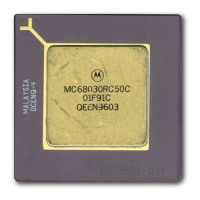Instruction Set Summary
MOTOROLA MC68030 USER’S MANUAL 3-19
Notations for operations that have two operands, written 〈operand〉 〈op〉 〈operand〉 , where
〈op〉 is one of the following:
→ — The source operand is moved to the destination operand
↔ — The two operands are exchanged
+ — The operands are added
– — The destination operand is subtracted from the source
operand
x — The operands are multiplied
÷ — The source operand is divided by the destination operand
< — Relational test, true if source operand is less than destina-
tion operand
> — Relational test, true if source operand is greater than des-
tination operand
V — Logical OR
⊕ — Logical exclusive OR
Λ — Logical AND
shifted by, rotated by — The source operand is shifted or rotated by the number of
positions specified by the second operand
Notation for single-operand operations:
~〈operand〉
— The operand is logically complemented
〈operand〉
sign-extended— The operand is sign extended; all bits of the upper portion
are made equal to the high-order bit of the lower portion
〈operand〉
tested — The operand is compared to zero and the condition codes
are set appropriately
Notation for other operations:
TRAP — Equivalent to Format/Offset Word
→ (SSP); SSP –2
→ SSP; PC→ (SSP); SSP – 4 → SSP; SR→ (SSP);
SSP–2
→ SSP; (vector) → PC
STOP — Enter the stopped state, waiting for the interrupts
If 〈condition〉 then — The condition is tested. If true, the operations
〈operations〉 else — after "then'' are performed. If the condition is
〈operations〉 — false and the optional "else'' clause is present, the opera-
tions after "else" are performed. If the condition is false and
else is omitted, the instruction performs no operation. Refer
to the Bcc instruction description as an example.

